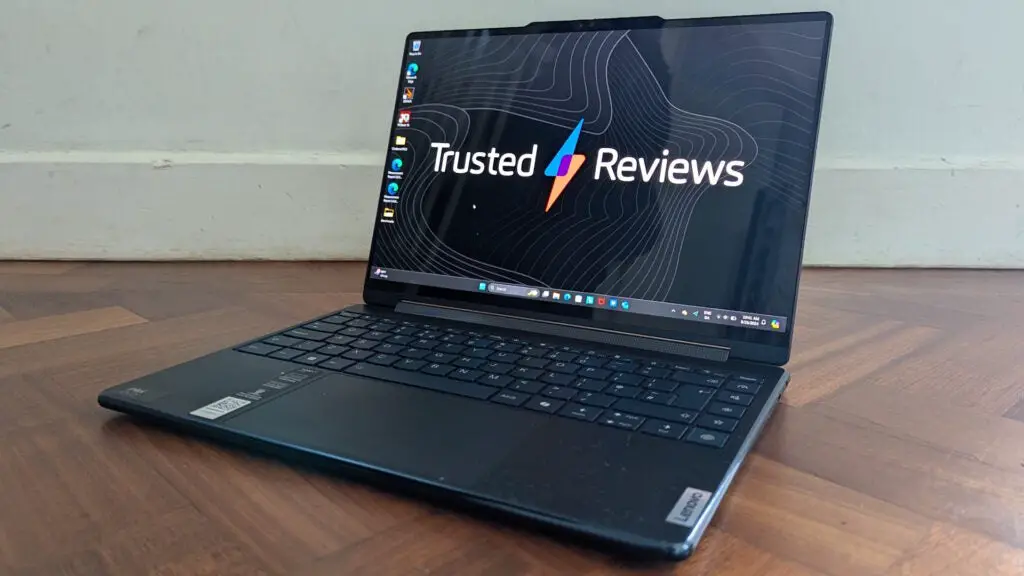Verdict
A beautiful, flexible, convertible laptop that makes a great all-rounder. Performance and battery life aren’t spectacular, but it’s consistently a joy to use.
Pros
- Looks fantastic
- The screen is truly eye-catching
- Great keyboard with a satisfying stylus to boot
Cons
- Battery life has been bested elsewhere
- Not quite as powerful as other ARM laptops
Key Features
- 2-in-1 designCan flip between laptop and keyboard mode by simply rotating the hinge.
- Intel Core Ultra processorsThe move to the 14th generation of Intel chips boosts performance and enables AI functionality.
- OLED screenFeatures an OLED screen to maximise contrast, resulting in inky blacks and bright colours.
Introduction
The Lenovo Yoga 9i 2-in-1 is a slimline 14-inch convertible aimed at creatives – or at least home users with creative aspirations. It appears to be a growing market these days, with manufacturers keen to show that they can produce small, lightweight devices that still deliver excellent performance for video, photo-editing and other arty applications.
However, Lenovo’s Yoga sub-brand has been doing it longer than most, and previous versions of the 9i 2-in-1 have been consistently impressive, albeit with some minor flaws. Plus, while it doesn’t have every feature you might wish for – for instance, there’s no dedicated GPU – it’s a relatively affordable machine with a powerful spec and a superb OLED screen. If you want a quiet, lightweight laptop for serious use, it might be exactly what you’re after.
I’ve spent a big chunk of the last week putting the Yoga 9i 2-in-1 through its paces, so here’s what I think.
Design and keyboard
- Practical 2-in-1 design with beautiful blue metallic chassis
- Minimal connectivity, but Lenovo bundles in a compact USB-C dock
- Fantastic keyboard that feels great under the fingers
Lenovo’s latest Yoga 9i design isn’t as ostentatious as its 2021 effort; there’s no leather lid to be found here. Instead, it’s simple and elegant, with a lovely dark-blue finish that Lenovo describes as Cosmic Blue, and a flexible aluminium frame that’s just 15.3mm thick and 1.35Kg in weight.
The thick central hinge allows you to use it in a tent or tablet configuration, as well as the standard clamshell mode, and it also houses the speaker system, making sure you get good audio however you’ve posed the device. The Yoga 9i is a little too large to work effectively as a tablet, but it’s great for sketching flat on the desk or watching Netflix while in tent mode, and this versatility doesn’t come at any cost when you’re just trying to use the Yoga as a laptop.
It also feels reassuringly tough. The hinge has a smooth action but is stiff enough to provide ample screen support, while there’s minimal flex in the body and barely any in the lid.
The thin stature of the chassis comes at a cost, and it’s connectivity. You get two Thunderbolt 4 ports on the left-hand side and a single USB 3.2 Gen 1. On the right you have a USB 3.2 Gen 1 Type-C and the 3.5mm audio socket. That’s it. However, showing foresight Lenovo has bundled in a compact USB-C dock, with an additional Type-A port and HDMI and old-school VGA outputs. You won’t have to worry about networking either as the Yoga has Wi-Fi 6E built-in.
I’m not sure that the Yoga 9i’s keyboard is equal to that of the brand’s best ThinkPad keyboards, but it’s as close as you’re going to get on a device this slim. The keys have Lenovo’s distinctive rounded bottoms and are ever-so-slightly concave. The result is that your fingers just seem to find them and fall onto them naturally.
The 1.5mm of travel makes for satisfying feedback, there’s a soft click as you type, and the overall feel is fast and light. My only grumble is that Lenovo has placed a column of function keys running down the right-hand side, which I can’t stop hitting when I reach for the Return, right-shift or backspace keys, sometimes switching the screen to the yellow-tinted eyecare mode inadvertently. I also had to keep reminding myself that the Yoga 9i has a fingerprint scanner, as it’s weirdly integrated into a fake key at the bottom of this column.
The touchpad is significantly wider than it is tall, at 13.3 by 7.8 cm, but it’s silky smooth and pretty flawless in its tracking, working as well for detailed adjustments in an image-editor as for straightforward Web browsing and navigating Windows. Again, though, I had an odd problem where two-fingered scrolling gestures were sometimes misinterpreted as three-fingered gestures, and the Windows desktop switcher launched. This happened enough to be mildly annoying.
Lenovo supplies the Yoga 9i with an active Slim Pen stylus which attaches magnetically to the case. I’m not much of an artist, but I found it great for quick doodles, notes and annotations, while adding to the Yoga’s creative potential.
Screen
- Vibrant OLED panel with 1800p resolution and 16:10 aspect ratio
- Perfect sRGB and DCI-P3 coverage
- Speakers in the hinge sound better than you might expect
Much as I love the overall design of the Yoga 9i, the screen might be the best thing about it. It’s a pretty stunning 14-inch OLED panel with the now trendy (and squarer) 16:10 aspect ratio and a 2880 x 1800 resolution and a 243ppi pixel density, which I think is as far as you need to go on a screen this size. It’s not ludicrously bright; I measured SDR brightness at 393 nits, which was still fine for working next to a window on a bright summer’s day. However, clarity is excellent, blacks are perfectly dark and colours bold and vibrant. It’s a superb display for productivity – a little more comfortable than the 13 to 13.6-inch screens appearing on the best ultrabooks – but also brilliant for entertainment and more creative work. Watching movies just to gauge battery life, I found it hard to drag my eyes away from the screen.
My subjective opinions are backed up by the test results. The Yoga 9i’s screen covers 100% of the sRGB colour gamut with a volume of 173%, and 99.9% of the DCI-P3 gamut with a volume of 123%. It even handles nearly all of the tricky Adobe RGB gamut, with 97.3% coverage and 119.5% volume. Even creative pros won’t have any issues with colour reproduction or accuracy – the Average Delta E I recorded was just 1.
I wasn’t sure what kind of audio system you could house within a hinge, but the output is surprisingly full-bodied and powerful, so I didn’t have to reach for headphones when watching movies or TV. There’s just enough bass to make you feel that you’re not missing the low end, and there’s even a decent stereo spread. Plus, as I’ve already said, it works as well in tent or tablet mode as in the standard clamshell configuration, so there’s no downside to using those for entertainment.
I was slightly disappointed by the webcam’s performance. Images are bright, but it seems to struggle with one-sided lighting and I’ve seen more detail and definition elsewhere, despite a maximum 1440p/30fps resolution. Still, it’s perfectly adequate for video calls and meetings, where the onboard mic array works well to capture clear and intelligible sound.
Performance
- Good mainstream performance from Core Ultra 7 CPU
- Arc GPU improves on basic integrated graphics, but it’s not as fast as a dedicated chip
- Very quiet until you push it hard
The Yoga 9i uses Intel’s Core Ultra 7 155H CPU; a chip we’ve seen a lot this year in performance-oriented thin-and-light laptops. It’s teamed with 16GB of DDR5 RAM in our test sample, though you can splash out extra on a configuration with 32GB. Performance is pretty much what we’d expect from this specification. The Core Ultra 7 has more than enough power for productivity and creative applications, even if you’re working on massive layered files in Photoshop or compositing with multiple 4K video streams. The integrated Intel Arc graphics can’t do the same work as a decent dedicated GPU, but they’re fast enough to accelerate rendering tasks or handle some lightweight gaming, though you’ll need to keep the resolution to 1080p or lower and the graphics settings to Low or Medium. Even then, you’re looking at a target 30fps in more demanding games.
In our tests, the Yoga 9i consistently scored higher than the MSI Prestige 14 AI Evo C1M, where our test model used the Core 5 Ultra 125H, not to mention the LG Gram Pro 16, which has the same Core Ultra 7 CPU but double the RAM. It delivered similar results to the Acer Swift Go 14, which has a nearly identical spec. The Acer was faster in the Cinebench R23 benchmark, while the Gram Pro 16’s dedicated GPU gives it the edge in 3DMark, but any other speed differences come down more to size and cooling systems, where the Acer’s larger build and fans give it an advantage. The Yoga 9i isn’t silent all the time, but you can only hear the fans kick in when it’s being pushed.
It’s tricky to make apples to apples comparisons with the new Qualcomm Snapdragon-powered CoPilot+ PCs when they don’t currently run our full suite of benchmarks. What I can tell you though is that the new Surface Laptop 7 with the Snapdragon X Elite is slower than the Yoga 9i in Geekbench’s single-core tests but faster in the multi-core tests. Provided your most-used apps will all run on ARM hardware, the Surface Laptop 7 or Surface Pro 11 might also be serious competition.
Confusingly, our review model came with a 1TB SSD, now only available with the more expensive 32GB version of this laptop if you buy in the UK. The 16GB version has a smaller 512GB drive unless you upgrade yourself with Lenovo’s Build Your Own configuration tools. It’s fast, with sequential read/write speeds of 6188MB/sec and 4702MB/sec, so it’s not going to slow you down in video or graphics applications where speedy storage is a must.
Software
- Minimal unwanted bloatware
- Lenovo Vantage is accessible, but not for in-depth tweakers
Lenovo has been quite restrained with software on the Yoga 9i. There’s a pre-installed promotion for Dropbox, a trial version of McAfee and a Dolby Access utility to tweak the audio, but that’s about it for third-party stuff. Lenovo, meanwhile, provides system tools and updates through its well-established Vantage app.
Cheerfully, this doesn’t launch on start-up by default, so it’s not always running unless you want it to, and it provides useful info on your laptop, the battery and warranty, plus some slightly annoying prompts to purchase additional warranty and services. The tools included cover simple optimisation routines, modes for different activities and sound and input options, but not much in the way of serious performance tweaking.
Battery life
- 75Whr battery will get you through the day and more
- Enough power to keep streaming video for over six hours on full brightness
A year ago I’d have been praising the Yoga 9i for its all-day battery life. In fact, the 11 hours and two minutes it lasted in PC Mark 10’s Modern Office benchmark is still perfectly respectable. However, the new breed of CoPilot+ PCs have moved the goalposts somewhat – the Surface Laptop 7 will keep on streaming video for 22 hours – and even some of the new AMD Strix Point laptops are posting better figures, though we’ve yet to review any here yet. You’ll get a day’s work done without a recharge and then some, but you’ll still want to plug it in when you start work for the next day.
Left to stream Netflix at full brightness for an hour sees the Yoga 9i’s battery drain by 16%, so you might want to keep a charger handy if you’re looking to binge through your downloads on a long journey.
Latest deals
Should you buy it?
You should buy for its flexible 2-in-1 design and stunning screen:
The Yoga 9i 2-in-1 looks and feels fantastic, with an excellent keyboard, a superb display and impressive sound. The flexible form factor makes it hugely versatile, but without any compromises that get in the way of using it as a laptop.
You should not buy if you need more performance or a longer battery life:
If you’re not fussed with the convertible design, we’re seeing other thin-and-light laptops that will give you more performance, while the new CoPilot+ PCs have the Yoga beaten on multi-core speeds and battery life.
Final Thoughts
There are areas where the Yoga 9i doesn’t excel. It’s performance is great across all mainstream apps, but nothing particularly special. It’s battery life is good, but a few hours short of stellar. Yet there’s something about the 2-in-1 design, the screen and the keyboard that makes this a great laptop for everyday use, both at home and on the go. It’s beautifully constructed and fabulous to look at, while being fast enough for anything except gaming and the most demanding creative tasks. What’s more, when you look at the price tag, it’s great value to boot.
For those seeking out more power, give the new Microsoft Surface Laptop 7 a look, as well as the MSI Prestige 14 AI Evo C1M.
How we test
Every laptop we review goes through a series of uniform checks designed to gauge key factors, including build quality, performance, screen quality and battery life.
These include formal synthetic benchmarks and scripted tests, plus a series of real-world checks, such as how well it runs popular apps.
We used as our main laptop for at least a week.
We test the performance via both benchmark tests and real-world use.
We test the screen with a colorimeter and real-world use.
We test the battery with a benchmark test and real-world use.
You might like…
FAQs
Is the Lenovo Yoga 9i 2-in-1 (2024) good for gaming?
You can get away with some light gaming at 30fps on the Lenovo Yoga 9i 2-in-1 (2024), but don’t expect to push it further than that.
Full specs
USA RRP
CPU
Manufacturer
Screen Size
Storage Capacity
Battery
Size (Dimensions)
Weight
Operating System
Release Date
Resolution
Refresh Rate
Ports
GPU
RAM
Connectivity
Colours
Display Technology
Touch Screen
Convertible?
Lenovo Yoga 9i 2-in-1 (2024)
$1449.99
Intel Core Ultra 7
Lenovo
14 inches
1TB
75 Whr
315 x 218 x 15.9 MM
1.35 KG
Windows 11
2024
3840 x 2400
60 Hz
Thunderbolt 4, USB-A, Audio Jack,
Intel Arc
16GB
Bluetooth 5.3 and Wi-Fi 6E
Cosmic Blue / Luna Grey
OLED
Yes
Yes










